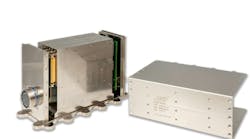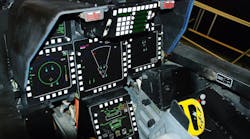"We see a lot more I/O these days going directly on the processing modules themselves, or implemented as mezzanine cards," says Anne Mascarin, solution marketing manager at Mercury Computer Systems in Chelmsford, Mass. "There is a lot of flexibility in I/O and where it resides. It really depends on the application."
I/O functionality that resides directly on single-board computers or as mezzanine cards plugged into these single-board computers can be implemented as specialized I/O matched to the application, or can be industry-standard I/O. "Most of our processing boards come with standard interfaces," Mascarin explains. "We are adding our GPIO line, which stands for General-Purpose I/O, which are discrete input/output lines but without a specific protocol. It is I/O wires and pins that the customer can define the protocol they want to run over it."
Although demand for standard I/O implemented on stand-alone boards appears to be winding down, I/O suppliers do field requests from systems integrators involved in upgrades and technology insertion who want to retain I/O on separate boards. "In some of the systems we have announced, our customers are still making 6U and 3U I/O boards, and we will include that in the system," Mascarin says.
"Our customers, and COTS companies like ourselves, are very much going away from I/O-based cards," says Steven Edwards, chief technology officer at Curtiss-Wright Controls Embedding Computing in Ashburn, Va. "The days of the 6U and the 3U data-acquisition card have gone by the wayside, and either the I/O is incorporated onto base cards that serve another function like a single-board computer, or primarily it is incorporated on mezzanine cards."
Ever-increasing bandwidth of I/O in high-performance embedded computing can make implementing I/O on mezzanine cards a challenge, but new standards are meeting many new demands. The FMC card, which stands for FPGA mezzanine card, is designed specifically for field-programmable gate array architectures.
Still, some applications that call for the quickest possible I/O still call for specialized stand-alone boards. "You closely couple I/O to high-bandwidth processing to match requirements, but sometimes you step past what is possible with a mezzanine," explains Jeremy Banks, product marketing manager for sensors and I/O processing at the Curtiss-Wright Controls Embedded Computing office in High Wycombe, England.
"The very high ends of bandwidth, like 1 gigabyte per second, you do hit a boundary where some I/O mezzanines can't cope with that and it calls for a stand-alone board," Banks says. "The key thing is to choose the right mezzanine for the given bandwidth."
Not all I/O mezzanines can meet all system requirements. North Atlantic Industries Inc. in Bohemia, N.Y., specializes in I/O boards that can handle many different I/O schemes on one stand-alone board -- most often either 6U or 3U VME or Compact PCI.
"Our philosophy has been multifunction I/O on boards, on which you can put as many as six different I/O functions on a single 6U VME board," explains Lino Massafra, vice president of sales and marketing at North Atlantic Industries.
Shipboard missile launchers are one example of multiple I/O on a board, Massafra explains. "Where you are monitoring a launcher, we monitor all kinds of A/D [analog-to-digital conversion] and discrete. We can monitor on a single board as many as 60 A/D channels or as many as 60 D/A channels.
Among North Atlantic's major talents is synchro resolver measurement, which keeps precise track of system movements, such as missile launchers or deck guns. "On a ship, we need to manage the position of a gun," Massafra explains. "The gun has left-and-right, and up-and-down movement. We can measure the position of that gun, and combine with a synchro that measures the movement of the ship, so the gun is always pointing in the right direction."
Looking to the future of I/O, optical computing and fiber optics technology expected to play an important role. "Certainly today optical I/O is all front-panel based, and that can be a challenge for things that are conduction-cooled, or that need two-level maintenance," says Curtiss-Wright's Edwards.
VITA, the open-standards, open-markets trade organization in Fountain Hills, Ariz., is formulating the VITA-66 standard for fiber-optic I/O out the backplane. "In the future we'll see optical I/O on the base card directly," Edwards says. "The advantage of optical I/O is noise immunity. A sensor located a long distance from the processor can have an enhanced signal at the receiving end."
VITA-66 should be ratified sometime this year, Edwards says, and by the end of 2011 the market most likely will see some VITA-66 cards and backplanes.
I/O board company list
ACCES I/O Products Inc.
San Diego
http://accesio.com
Acqutek Corp.
Fullerton, Calif.
www.acqu.com
Acromag Inc.
Wixom, Mich.
www.acromag.com
ACT/Technico
Warminster, Pa.
www.acttechnico.com
ACTIS Computer Inc.
Tempe, Ariz.
www.actis-computer.com
ADLINK Technology Inc.
Irvine, Calif.
www.adlinktech.com
Advanced Digital Logic Inc.
San Diego
www.adl-usa.com
Advanced Microcomputer Systems Inc.
Pompano Beach, Fla.
www.advancedmsinc.com
Advantech Corp., Industrial Automation Group
Cincinnati, Ohio
www.advantech.com
ALPHI Technology Corp.
Tempe, Ariz.
www.alphitech.com
Annapolis Micro Systems Inc.
Annapolis, Md.
www.annapmicro.com
API Alliance Inc.
Fort Wayne, Ind.
www.apiallianceinc.com
Axiomatic Technologies Corp.
Mississauga, Ontario
www.axiomatic.com
Bustec Production Ltd.
North Ridgeville, Ohio
www.bustec.com
Curtiss-Wright Controls Electronic Systems
Dayton, Ohio
www.cwcelectronicsystems.com
Custom Control Systems Inc.
New Hartford, N.Y.
www.customcontrolsystems.com
Dataforth Corp.
Tucson, Ariz.
www.dataforth.com
Diamond Systems Corp.
Mountain View, Calif.
www.diamondsystems.com
DSP Control Group Inc.
Minneapolis, Minn.
www.dspcg.com
dSPACE Inc.
Wixom, Mich.
www.dspaceinc.com
Dynatem Inc.
Mission Viejo, Calif.
www.dynatem.com
Emerson Network Power Embedded Computing
Tempe, Ariz.
www.emersonnetworkpower.com
ESD Electronics Inc.
Greenfield, Mass.
www.esd-electronics-usa.com
GE Intelligent Platforms
Charlottesville, Va.
www.ge-ip.com
Grayhill Inc.
La Grange, Ill.
http://grayhill.com
Kontron USA
Poway, Calif.
www.kontron.com
Measurement Computing
Norton, Mass.
www.mccdaq.com
MEN Micro Inc.
Ambler, Pa.
www.menmicro.com
Mercury Computer Systems Inc.
Chelmsford, Mass.
www.mc.com
Mosaic Industries Inc.
Newark, Calif.
www.mosaic-industries.com
North Atlantic Industries Inc. (NAI)
Bohemia, N.Y.
www.naii.com
Octagon Systems Corp.
Westminster, Colo.
www.octagonsystems.com
OMEGA Engineering Inc.
Stamford, Conn.
www.omega.com
Opto 22
Temecula, Calif.
www.opto22.com
Parvus Corp.
Salt Lake City, Utah
www.parvus.com
Pentek Inc.
Upper Saddle River, N.J.
www.pentek.com
RTD Embedded Technologies Inc.
State College, Pa.
www.rtd.com
Sealevel Systems Inc.
Liberty, S.C.
www.sealevel.com
Sensoray Company Inc.
Tigard, Ore.
www.sensoray.com
Spectrum Controls Inc.
Bellevue, Wash.
www.spectrumcontrols.com
Spectrum Signal Processing
Burnaby, British Columbia
www.spectrumsignal.com
Technobox Inc.
Lumberton, N.J.
www.technobox.com
TEK Microsystems Inc.
Chelmsford, Mass.
www.tekmicro.com
place link phrase hereTri-M Systems and Engineering Inc.
Port Coquitlam, British Columbia
www.tri-m.com
VersaLogic Corp.
Eugene, Ore.
http://versalogic.com/
WinSystems Inc.
Arlington, Texas
www.winsystems.com
WAGO Corp.
Germantown, Wis.
www.wago.com



